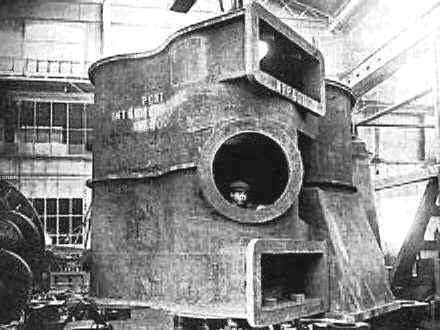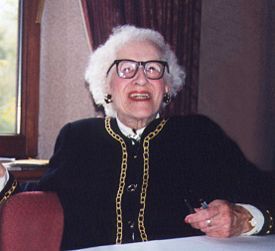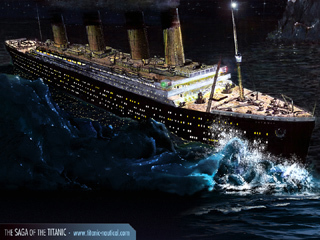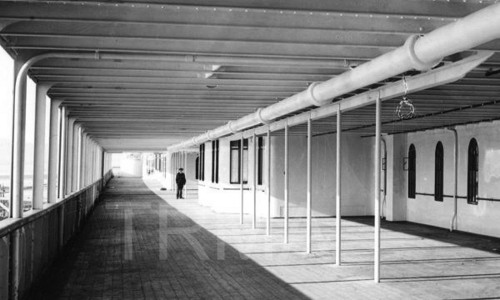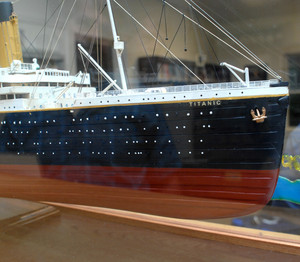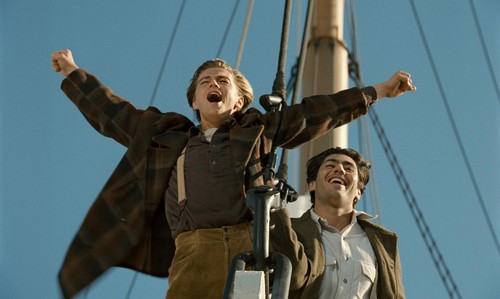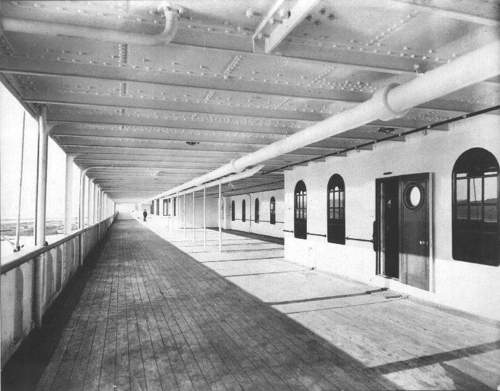One of the most controversial and complex theories was put forward by Robin Gardiner in his book, Titanic: The Ship That Never Sank? In it, Gardiner draws on several events and coincidences that occurred in the months, days, and hours leading up to the sinking of the Titanic, and concludes that the ship that sank was in fact Titanic's sister ship Olympic, disguised as Titanic, as an insurance scam.
Olympic was the older sister of Titanic, built alongside the more famous vessel but launched in October 1910. Her exterior profile was nearly identical to Titanic, save for small detailing such as the promenade deck windows. These were not glazed in Olympic. In Titanic, the front half of the promenade deck was fitted with smaller glazed windows to protect passengers from spray.
On September 20, 1911, the Olympic was involved in a collision with the Royal Navy cruiser HMS Hawke near Southampton. The cruiser smashed its ram into the side of the Olympic, seriously damaging both ships. The inquiry found Hawke free of all blame. This set in motion Gardiner's theory. White Star Line was allegedly not insured for the cost of fixing the damaged Olympic (which, according to Gardiner, had damaged the central turbine's mountings and the keel). The White Star's flagship would also be out of action during any repairs, and the Titanic's completion date would have to be delayed. All this would amount to a serious financial loss for the company. Gardiner proposes that, to make sure at least one vessel would be earning money. Olympic was then converted to become the Titanic. Gardiner states that few parts of either ship bore the name, other than the easily removed lifeboats, bell, compass binnacle, and name badges. Thus, Gardiner believes the Titanic spent 25 years in service as the Olympic.
Gardiner uses as evidence the length of Titanic's sea trials. Olympic's trials in 1910 took two days, including several high speed runs, but Titanic's trials reportedly only lasted for one day, with no working over half-speed. Gardiner says this was because the patched-up hull could not take any long periods of high speed.
Gardiner suggests the plan was to dispose of the Olympic to collect insurance money. He supposes that the seacocks were to be opened at sea to slowly flood the ship. If numerous ships were stationed nearby to take off the passengers, the shortage of lifeboats would not matter as the ship would sink slowly and the boats could make several trips to the rescuers.
Gardiner maintains that on April 14, Officer Murdoch was not officially on duty yet was on the bridge because he was one of the few high-ranking officers who knew of the plan and was keeping a watch out for the rescue ships. One of Gardiner's most controversial statements is that the Titanic did not strike an iceberg, but an IMM rescue ship that was drifting on station with its lights out. Gardiner based this hypothesis on the idea that the supposed iceberg was seen at such a short distance by the lookouts on the Titanic because it was actually a darkened ship, and he also does not believe an iceberg could inflict such sustained and serious damage to a steel double-hulled (sic) vessel such as the Titanic.
Gardiner further hypothesizes that the ship that was hit by the Titanic was the one seen by the Californian firing distress rockets, and that this explains the perceived inaction of the Californian (which traditionally is seen as failing to come to the rescue of the Titanic after sighting its distress rockets). Gardiner's hypothesis is that the Californian was not expecting rockets, but a rendezvous. The ice on the deck of the Titanic is explained by Gardiner as ice from the rigging of both the Titanic and the mystery ship it hit. Researchers Bruce Beveridge and Steve Hall took issue with many of Gardiner's claims in their book, Olympic and Titanic: The Truth Behind the Conspiracy. Author Mark Chirnside has also raised serious questions about the switch theory. There is also evidence that Gardiner's theory is not true. When parts of the wreck were recovered, the construction number 401 was found on all of them. 401 was the Titanic's construction number, the number of the Olympic was 400.
Olympic was the older sister of Titanic, built alongside the more famous vessel but launched in October 1910. Her exterior profile was nearly identical to Titanic, save for small detailing such as the promenade deck windows. These were not glazed in Olympic. In Titanic, the front half of the promenade deck was fitted with smaller glazed windows to protect passengers from spray.
On September 20, 1911, the Olympic was involved in a collision with the Royal Navy cruiser HMS Hawke near Southampton. The cruiser smashed its ram into the side of the Olympic, seriously damaging both ships. The inquiry found Hawke free of all blame. This set in motion Gardiner's theory. White Star Line was allegedly not insured for the cost of fixing the damaged Olympic (which, according to Gardiner, had damaged the central turbine's mountings and the keel). The White Star's flagship would also be out of action during any repairs, and the Titanic's completion date would have to be delayed. All this would amount to a serious financial loss for the company. Gardiner proposes that, to make sure at least one vessel would be earning money. Olympic was then converted to become the Titanic. Gardiner states that few parts of either ship bore the name, other than the easily removed lifeboats, bell, compass binnacle, and name badges. Thus, Gardiner believes the Titanic spent 25 years in service as the Olympic.
Gardiner uses as evidence the length of Titanic's sea trials. Olympic's trials in 1910 took two days, including several high speed runs, but Titanic's trials reportedly only lasted for one day, with no working over half-speed. Gardiner says this was because the patched-up hull could not take any long periods of high speed.
Gardiner suggests the plan was to dispose of the Olympic to collect insurance money. He supposes that the seacocks were to be opened at sea to slowly flood the ship. If numerous ships were stationed nearby to take off the passengers, the shortage of lifeboats would not matter as the ship would sink slowly and the boats could make several trips to the rescuers.
Gardiner maintains that on April 14, Officer Murdoch was not officially on duty yet was on the bridge because he was one of the few high-ranking officers who knew of the plan and was keeping a watch out for the rescue ships. One of Gardiner's most controversial statements is that the Titanic did not strike an iceberg, but an IMM rescue ship that was drifting on station with its lights out. Gardiner based this hypothesis on the idea that the supposed iceberg was seen at such a short distance by the lookouts on the Titanic because it was actually a darkened ship, and he also does not believe an iceberg could inflict such sustained and serious damage to a steel double-hulled (sic) vessel such as the Titanic.
Gardiner further hypothesizes that the ship that was hit by the Titanic was the one seen by the Californian firing distress rockets, and that this explains the perceived inaction of the Californian (which traditionally is seen as failing to come to the rescue of the Titanic after sighting its distress rockets). Gardiner's hypothesis is that the Californian was not expecting rockets, but a rendezvous. The ice on the deck of the Titanic is explained by Gardiner as ice from the rigging of both the Titanic and the mystery ship it hit. Researchers Bruce Beveridge and Steve Hall took issue with many of Gardiner's claims in their book, Olympic and Titanic: The Truth Behind the Conspiracy. Author Mark Chirnside has also raised serious questions about the switch theory. There is also evidence that Gardiner's theory is not true. When parts of the wreck were recovered, the construction number 401 was found on all of them. 401 was the Titanic's construction number, the number of the Olympic was 400.
The R.M.S. Titanic was a very grand ship. The biggest, fastest, and fanciest ship of its time. It was indeed a good ship stopped by a little mistake that scientist's still studying around the world today almost 120 years ago. The titanic in my opinion is quite interesting and it has surprisingly, over 100,0000 theories about all kinds of subjects. The titanic is still at the bottom of the ocean today and is full of interesting artifacts.
The Titanic sank off the west coast of Newfoundland, Canada. One of the most interesting artifacts is a woman who died on the titanic tied her necklace to the railing of the titanic with a note in it reading, Hello, good day. He betrays me so I take his life. the rest of the note was not found because it was ripped in half. for me, that was very interesting to read this.
The Titanic sank off the west coast of Newfoundland, Canada. One of the most interesting artifacts is a woman who died on the titanic tied her necklace to the railing of the titanic with a note in it reading, Hello, good day. He betrays me so I take his life. the rest of the note was not found because it was ripped in half. for me, that was very interesting to read this.




